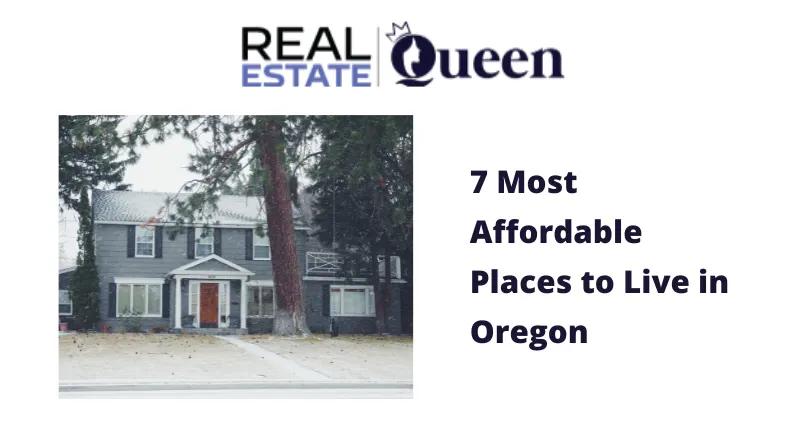
Median home value of most affordable places to live in Oregon stands at $496,876, representing a 0.4% decrease from the previous year, while the state’s overall cost of living runs 10% higher than the national average. Despite higher housing costs compared to some regions, Oregon’s zero sales tax policy and moderate property tax rate of 0.84% create substantial savings opportunities for residents across income brackets.
Whether you envision weekend trips to Crater Lake National Park or lazy afternoons exploring the Columbia River Gorge, Oregon’s most affordable cities make that lifestyle accessible without breaking your budget. This comprehensive guide reveals where your dollar stretches furthest in the Pacific Northwest’s most diverse and naturally stunning state.
Key Takeaways
- Baker City offers the lowest housing costs with median home prices at $250,065 and rent ranging from $950-1,300, delivering 15% cost savings below the national average.
- Oregon residents save approximately $2,500-4,000 annually through zero sales tax compared to states with 6-8% sales tax rates on typical household spending.
- La Grande provides the most affordable rental market with median rent between $774-850, perfect for young professionals and university-connected residents.
- Eastern Oregon communities deliver 6-15% cost savings below national averages while maintaining access to outdoor recreation and cultural amenities.
- Property tax rates average 0.84% statewide, ranking Oregon 25th nationally and providing predictable housing costs for long-term residents.
Comparing Most Affordable Places to Live in Oregon
| City | Median Home Price | Median Rent | Cost of Living vs US | Best For |
| Baker City | $250,065 | $950-1,300 | -15% | Outdoor enthusiasts |
| Klamath Falls | $276,835 | $1,400 | -2% | Families |
| La Grande | $274,875 | $774-850 | -8% | Young professionals |
| Coos Bay | $330,402 | $2,300 | -6% | Coastal lovers |
| Woodburn | $427,524 | $1,122 | -5% (vs OR) | Multicultural families |
| Ontario | $321,175 | $1,050 | -8% | Border commuters |
| Roseburg | $320,658 | $1,200 | -7% | Wine enthusiasts |
7 Most Affordable Places to Live in Oregon in 2025
1. Baker City
- Median Home Price: $250,065
- Median Rent: [$950-1,300](web Cost of Living: 15% below US average
- Best For: Retirees, outdoor enthusiasts, remote workers
- Highlights: Anthony Lakes Ski Area, Victorian architecture, Eagle Cap Wilderness access
Baker City captures the authentic spirit of Oregon’s mining heritage while serving as an outdoor recreation paradise. The preserved Victorian downtown district showcases original 1890s architecture, while Baker High School consistently ranks among the region’s top educational institutions. Historic Geiser Grand Hotel provides luxury accommodations that attract visitors from across the Pacific Northwest.
The local economy benefits from tourism, agriculture, and remote work opportunities, with median household incomes supporting comfortable lifestyles. However, residents face challenges including harsh winters with significant snowfall and limited shopping options requiring trips to larger cities. The nearest major medical facilities are located over 100 miles away in Boise or Pendleton.
👉Affordable small-town living in Eastern Oregon. Start your Baker City homes for sale search today.
2. Klamath Falls
- Median Home Price: $276,835
- Median Rent: $1,400
- Cost of Living: 2% below US average
- Best For: Families, students, lake recreation enthusiasts
- Highlights: Oregon Institute of Technology, Upper Klamath Lake, Crater Lake proximity
Klamath Falls combines small-town charm with educational excellence through Oregon Institute of Technology and Klamath Community College. The geothermal-heated Ella Redkey Pool provides year-round swimming, while Running Y Ranch Resort features Oregon’s only Arnold Palmer-designed golf course. Ross Ragland Theater hosts nationally recognized performances throughout the year.
The diverse economy includes education, healthcare, and renewable energy sectors, creating stable employment opportunities for residents. Economic challenges include seasonal tourism fluctuations and occasional air quality issues during wildfire season. Limited cultural dining options require residents to travel to larger metropolitan areas for diverse culinary experiences.
👉Affordable high-desert living with mountain views. Start your Klamath Falls homes for sale search today.
3. La Grande
- Median Home Price: $274,875
- Median Rent: $774-850
- Cost of Living: 8% below US average
- Best For: Young professionals, university families, academic communities
- Highlights: Eastern Oregon University, Mount Emily Recreation Area, arts scene
La Grande thrives as a vibrant university town where Eastern Oregon University creates a dynamic cultural and intellectual atmosphere. The Mount Emily Recreation Area trail system offers extensive hiking and mountain biking opportunities just minutes from downtown. University galleries and theaters provide year-round cultural programming that rivals much larger cities.
The economy centers around education, healthcare, and outdoor recreation industries, with 83.9% of residents being white and 25% holding bachelor’s degrees. Challenges include limited employment diversity beyond education and seasonal student population fluctuations affecting local businesses. The average commute time of just 13 minutes makes daily life exceptionally convenient.
👉Affordable mountain living with small-town charm. Start your La Grande homes for sale search today
4. Coos Bay
- Median Home Price: $330,402
- Median Rent: $2,300
- Cost of Living: 6% below US average
- Best For: Coastal lifestyle seekers, retirees, maritime professionals
- Highlights: Oregon Coast’s largest city, Oregon Dunes National Recreation Area, maritime culture
Coos Bay serves as the Oregon Coast’s premier city, offering genuine maritime character alongside modern amenities and services. The Oregon Dunes National Recreation Area provides unique desert-meets-ocean recreation experiences, while Marshfield High School maintains strong academic and athletic programs. Coos Historical and Maritime Museum showcases the region’s rich logging and fishing heritage.
The local economy depends on healthcare, education, tourism, and declining timber industries, creating economic diversification challenges. Residents experience higher crime rates than the state average and frequent coastal weather including rain and fog. The annual Oregon Coast Music Festival brings national recognition and substantial tourism revenue to the region.
👉Affordable coastal living on Oregon’s South Coast. Start your Coos Bay homes for sale search today.
5. Woodburn
- Median Home Price: $427,524
- Median Rent: $1,122
- Cost of Living: 5% below Oregon state average
- Best For: Multicultural families, agricultural workers, suburban commuters
- Highlights: Woodburn Premium Outlets, Hispanic cultural festivals, Russian Old Believer community
Woodburn celebrates extraordinary cultural diversity where 54.1% Hispanic population creates vibrant multilingual communities alongside established Russian Old Believer traditions. The Woodburn Premium Outlets attract shoppers from across the Pacific Northwest, while local restaurants serve authentic international cuisine reflecting community heritage. Annual Fiesta Mexicana draws thousands of visitors celebrating Hispanic culture.
Salem’s proximity provides metropolitan employment opportunities within a 24-minute commute, supporting the median household income of $67,469. Traffic congestion during peak outlet shopping seasons creates temporary inconveniences, while language barriers occasionally affect community service access. Higher property taxes compared to surrounding rural areas reflect increased municipal services and amenities.
👉Affordable living in Oregon’s agricultural hub. Start your Woodburn homes for sale search today.
6. Ontario
- Median Home Price: $321,175
- Median Rent: $1,050
- Cost of Living: 8% below US average
- Best For: Agricultural professionals, border commuters, warm climate seekers
- Highlights: Four Rivers Cultural Center, Japanese-American heritage, Snake River recreation
Ontario functions as Oregon’s eastern gateway, combining Oregon’s tax advantages with Idaho proximity for unique border community benefits. The Four Rivers Cultural Center showcases regional arts and celebrates Japanese-American heritage through year-round programming. Ontario High School and Pioneer Intermediate maintain strong academic standards serving the agricultural community.
The economy centers on agriculture, border commerce, and tourism, with strong Hispanic and Japanese-American populations contributing to cultural richness. Summer temperatures regularly exceed 100°F, while limited healthcare specialists require travel to Boise for specialized services. Seasonal employment patterns in agriculture create economic fluctuations throughout the year.
👉Affordable small-city living on Oregon’s eastern border. Start your Ontario homes for sale search today.
7. Roseburg
- Median Home Price: $320,658
- Median Rent: $1,200
- Cost of Living: 7% below US average
- Best For: Retirees, wine enthusiasts, fishing enthusiasts
- Highlights: Umpqua Valley wineries, world-class fishing, historic downtown
Roseburg embraces its transformation from historic timber town to wine country destination within the scenic Umpqua Valley. The Umpqua River provides world-renowned fishing opportunities, while surrounding wineries offer tours and tastings showcasing Oregon’s diverse viticultural regions. Historic downtown features antique shops, galleries, and preserved architecture celebrating pioneer heritage.
The growing wine industry attracts young professionals and tourism workers, while retirees appreciate the mild climate and outdoor recreation access. Wildfire smoke affects air quality during summer months, and the economic transition from timber creates employment uncertainty. Annual Graffiti Week celebrates 1950s culture with classic car shows drawing visitors from across the region.
👉Affordable living in the heart of the Umpqua Valley. Start your Roseburg homes for sale search today.
How We Ranked Oregon’s Most Affordable Cities in 2025
Our comprehensive analysis uses weighted criteria such as,
- Housing Costs (45%)
- Overall Cost of Living (25%)
- Local Economic Factors (15%)
- Quality of Life Indicators (10%)
- Community Infrastructure (5%)
Data sources include the Oregon Employment Department, U.S. Census Bureau, Zillow Home Value Index, Houzeo Cost of Living Calculator RentCafe Cost of Living Calculator, Oregon Department of Education, Bureau of Labor Statistics, local municipal economic development departments, and Oregon Housing and Community Services. All statistics reflect current market conditions and verified government data to ensure accuracy and reliability.
What Drives Affordability in Oregon?
Oregon’s unique tax structure significantly impacts overall affordability, with zero sales tax saving residents approximately $2,500-4,000 annually compared to states with 6-8% sales tax rates on typical household spending. The state’s moderate property tax rate of 0.84% ranks 25th nationally, providing predictable housing costs while funding essential services including education and infrastructure.
Housing costs vary dramatically by region, with eastern Oregon communities offering median home prices 30-40% below Portland metropolitan area while maintaining access to outdoor recreation and cultural amenities. Utility costs run 12% below the national average, while transportation expenses benefit from efficient public transit systems in larger cities and shorter commute times in smaller communities.
Smart Tips for Oregon Living
- Maximize tax savings by taking advantage of Oregon’s zero sales tax for major purchases including vehicles, appliances, and home improvements
- Consider eastern Oregon for 15-40% housing cost savings while maintaining access to outdoor recreation and small-town amenities
- Research utility costs carefully as geothermal heating in cities like Klamath Falls can provide significant energy savings year-round
- Factor in commute times when choosing between urban amenities and rural affordability, as many smaller cities offer 15-minute commutes versus Portland’s traffic congestion
- Explore university towns like La Grande for cultural programming, educational opportunities, and affordable rental markets
- Plan for seasonal weather including wildfire smoke, coastal rain, and mountain snow when selecting your ideal Oregon community
Should You Move to Oregon?
Most affordable places to live in Oregon prove that Pacific Northwest living doesn’t require sacrificing financial stability for natural beauty and outdoor recreation access. From Baker City’s Victorian charm and 15% cost savings to Coos Bay’s coastal lifestyle and maritime culture, each community offers unique advantages for different lifestyles and budgets.
These ten communities demonstrate Oregon’s remarkable diversity, combining zero sales tax benefits with moderate property taxes, stunning natural settings, and strong community foundations. Whether you prioritize university town culture, multicultural experiences, or outdoor recreation access, Oregon’s most affordable places provide exceptional value for residents seeking quality of life without premium price tags.
👉Find affordable homes for sale across Oregon and save thousands with Houzeo’s low commission platform.
Frequently Asked Questions
What is the most affordable place to live in Oregon?
Oregon's most affordable community is Baker City with median home prices of $250,065 and rent ranging from $950-1,300, while offering 15% cost savings below the national average and exceptional access to outdoor recreation.
What are the top 7 most affordable cities in Oregon?
The most affordable Oregon cities are Baker City, Klamath Falls, La Grande, Coos Bay, Woodburn, Ontario, Roseburg, each offering unique lifestyle benefits and cost savings.
Which Oregon cities are best for families on a budget?
Klamath Falls and La Grande provide excellent family-friendly environments with strong school systems, educational opportunities, and affordable housing options while maintaining access to cultural amenities and outdoor recreation.
Are there affordable beach towns in Oregon?
Yes, Coos Bay serves as Oregon Coast's most affordable city with median home prices around $330,402 and comprehensive amenities, while providing access to Oregon Dunes National Recreation Area and authentic maritime culture.
What makes Oregon one of the most affordable states?
Oregon's zero sales tax policy saves residents $2,500-4,000 annually, while moderate property tax rates of 0.84% and diverse geography provide affordable housing options from coast to mountains with exceptional quality of life benefits.






